Adobe FrameMaker Tutorial – Tables
Why Use Them?
Tables allow you to portray information, usually numerical data, in an organized and highly visible fashion. If you are comparing numerical data between things, tables are probably your best option. A “table,” itself, generally refers to a heading row (where you may put a title for your table), followed by at least one more “body row,” and at least one “column.” You can have multiple rows and multiple columns to help show your information.
Inserting a Table
You can insert a table virtually anywhere on the page. In your document, select the “Table” menu, and click “Insert Table.”
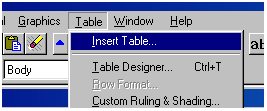 |
The “Insert Table” dialogue box should now appear. You’ll notice it is somewhat similar to the character and paragraph cataloges. You can use pre-made styles for your columns, or even create your own, later on. “Format A” and “Format B” are the two pre-made styles to choose from. The two are very similar. The only main difference is that “Format B” has much bolder lines surrounding the first body row, and comes centered. Before inserting the table, you can change the amount of rows and/or columns you would like it to have. “Columns” and “Body Rows” have been explained; a “Heading Row” is where you would put a title for your table, and a “footing row” is where you could, for example, put total calculations at the bottom of the table.
Using the Table
In the heading row, you can title your table anything you’d like. You can simply click inside or highlight to type. At any point in the table, you can press the “tab” key on your keyboard to move to the next “cell” in the table (a “cell” is any open block made from rows and columns). You can also click in any cell to begin typing in it.
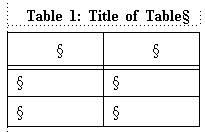 |
Resizing Cells
If you need a column to be wider than it is, click your cursor into the column you would like to resize. Choose the “Table” menu, and click “Resize Columns.” For the most part, you’ll probably want to use the “To Width” option, which allows you to use a specific, measured width. Change the number to whatever you would like, and click “Resize.”
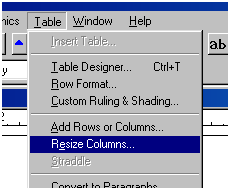 |
You can also “drag” a column to resize it. Place your cursor in the middle of any cell in the column you would like to resize, and click. Drag the mouse until the cell is highlighted, and continue dragging to the right (or left). The cell next to it will probably be highlighted, now, as well (that’s OK!). Now, drag the cursor BACK towards the first cell, so that ONLY that cell is highlighted. Let go of the mouse button. You should see a little black square on the side of the cell. Now, you can click on that square and drag the mouse to however wide you want the column to be.
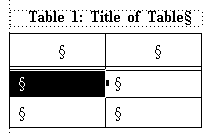 |
Adding Rows & Columns
If you find that you need an extra column or row, it is easy to add them in, even if your table has already been created and has content inside of it. Click inside a cell next to where you would like to add an item. Go to the “Table” menu, and select “Add Rows or Columns.”
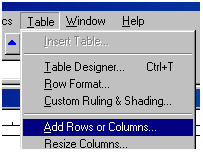 |
You’ll see a box come up that allows you complete control over what you can add. You can change the number of columns or rows to add, and by using the drop-down menu next to your choice, you can add: a row ABOVE your cell, a row BELOW your cell, a column LEFT of your cell, or a column RIGHT of your cell. Note that the new row or column you add will appear blank, with no information inside. After you’ve made your selections, simply click “Add.”
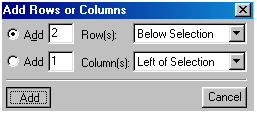 |
An easier way to add one row is to hold the “Control” key on your keyboard, and then hit the “Enter” key.
Merging Cells
You may want to combine two cells in your table, for some reason. Perhaps they have no data in them, and would just look better combined to one cell of white space, rather than two distinct ones. Select two (or more) cells that you would like to combine by highlighting them with the cursor. Choose the “Table” menu, and click “Straddle” (you can also right-click with the mouse and select “Straddle,” there, as well).
 |
Custom Ruling & Shading
You can change the appearance of the actual table, itself, at any point. Select a row, and use the “Custom Ruling and Shading” selection in the “Table” menu. In the “Apply Ruling Style” menu, you can choose different types of line styles to your selection (for example, a very thick line, rather than a thin line). Once you’ve made your selection, just hit “Apply.”
 |
If you want to fill in a cell with a color, you can also do this with the “Custom Ruling and Shading” menu. With any cell (or cells) highlighted, return to that menu. Near the bottom, choose the “Fill” menu to pick the percentage of fill you would like. Use the “Color” menu to also change the color you will be filling it, with. Once you’re done, click “Apply.”
 |
Note that if you want these changes to take effect, the “Custom Rule Shading” and “Custom Cell Shading” boxes MUST be checked in the “Custom Ruling and Shading” menu.


Comments